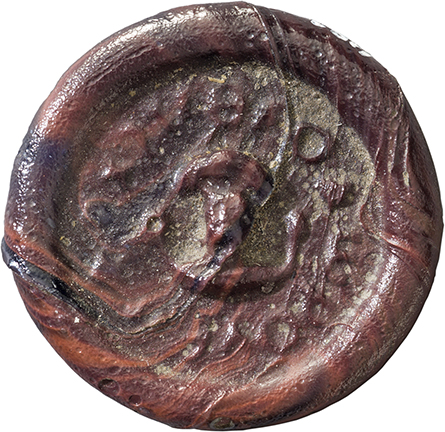
-
Copyright credit: Anatolian Weights and Measures Collection. Courtesy of Suna and İnan Kıraç Foundation Pera Museum / Bendeguz Tobias

ARCHAEOLOGICAL DESCRIPTION OF THE WEIGHT
Authority
Mint
Denomination
1 Scripulum = 1 Gramma
Material
Glass
Manufacture
Cast
Shape
Disc or similar (ellipse, etc.)
Length
1.85 cm
Width
1.85 cm
Height
0.25 cm
Metrology
| Mass (g) | Mass (grain) | Date of measurement | Reference | fragmented | cleaned | reference weight |
|---|---|---|---|---|---|---|
| 1.00 | - | - | (scientific literature) | No | No | Yes |
Iconography
| Symbol | Technique | Direction | Position | Number | Synecdoche |
|---|---|---|---|---|---|
| Cross in the inscription | |||||
| Wreath: inscription | |||||
| --- One imperial bust |
Wear
Corrosion
Handle
No
Suspension hole
No
Recarved mould
No
Recarved weight
No
Intentionally destroyed
No
Archaeological description
Glass weight. Disc. Colour (Farbe): rotbraun. Iconography: Cross in the inscription. Wreath: inscription. One imperial bust.
CPAI III/2: 7th century AD? Eastern Mediterranean. Weight for a silver coin (half siliqua). Glass, 18.5 x 2.5 mm; 1.00 g. Inv. no. PMA 1192. Acquired in 2005. Description: Brown coloured, opaque, thin round weight with a central impression. The dignitary in the centre is holding a mappa in his raised right hand and a sceptre in his left hand. His hair is stylized in a toric manner above his head. An inscription is located around the bust, to be read as ΘΕΟΔⲰPOV EΠAPXOV. Theodoros is a very common name. Therefore, an attribution to a certain prefect is yet quite impossible. The mass of the weight indicates that is was used for testing silver coins. Brown coloured weights of this type are very rare; more frequently they appear in a dark-blue colour, such as cat. no. 711.
CPAI III/2: 7th century AD? Eastern Mediterranean. Weight for a silver coin (half siliqua). Glass, 18.5 x 2.5 mm; 1.00 g. Inv. no. PMA 1192. Acquired in 2005. Description: Brown coloured, opaque, thin round weight with a central impression. The dignitary in the centre is holding a mappa in his raised right hand and a sceptre in his left hand. His hair is stylized in a toric manner above his head. An inscription is located around the bust, to be read as ΘΕΟΔⲰPOV EΠAPXOV. Theodoros is a very common name. Therefore, an attribution to a certain prefect is yet quite impossible. The mass of the weight indicates that is was used for testing silver coins. Brown coloured weights of this type are very rare; more frequently they appear in a dark-blue colour, such as cat. no. 711.
Autopsy
No
INSCRIPTION
| Language | Technique | Legend type |
|---|
Fac simile
Edition
Monogram
ARCHAEOLOGICAL CONTEXT
Findspot (region)
Findspot (site)
context
CIRCUMSTANCES OF ACQUISITION
Region
City
Date of first acquisition
circumstances
DATING OF THE WEIGHT
Curatorial Section
LATE ROMAN AND BYZANTINE
Time frame
Comments on Chronology
COLLECTION HISTORY
Collection
| Name | Date of acquisition | Inventory number |
|---|---|---|
| Pera Museum (Istanbul) | None | PMA 1192 |
Bibliography
| Reference | Page/Column | Reference (number) | Plate / Figure | Comment |
|---|---|---|---|---|
| CPAI III/2 | None | 710 | pl. 189 | None |
VARIA
Additional comment
2005 erworben.
CPAI III/2:Ref.: Whitehouse 2003: 37 no. 942.
CPAI III/2:Ref.: Whitehouse 2003: 37 no. 942.
Permalink
External link